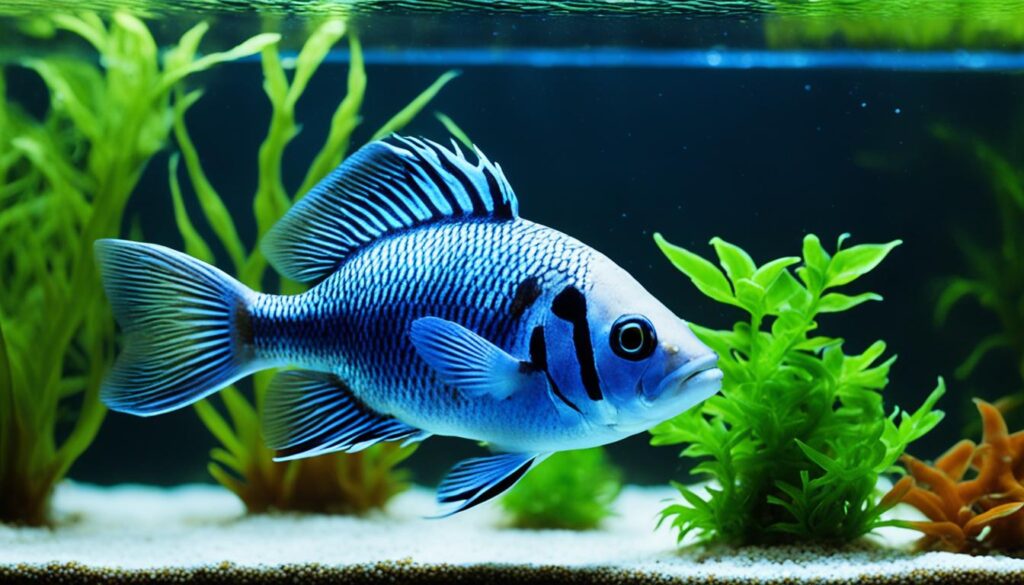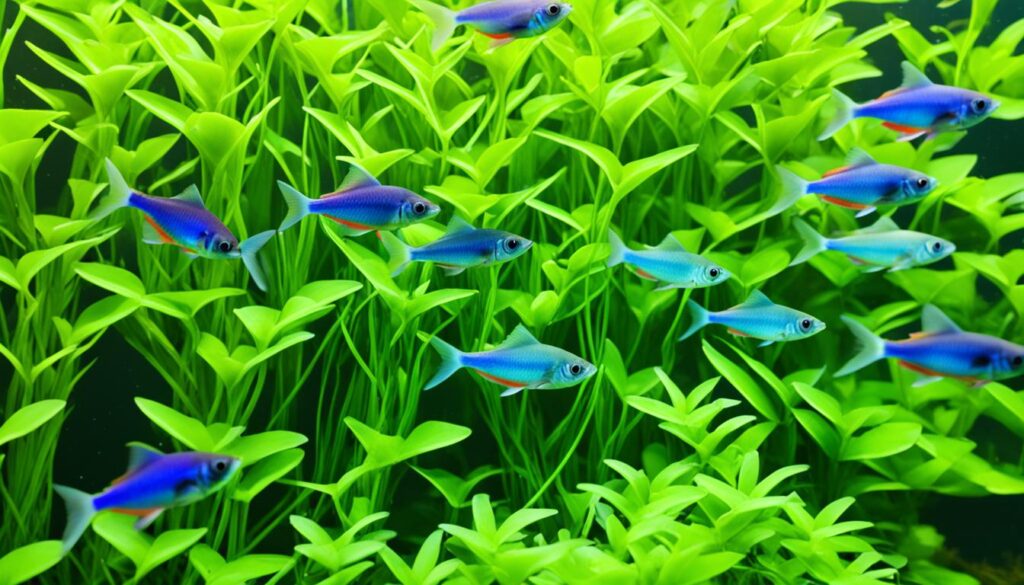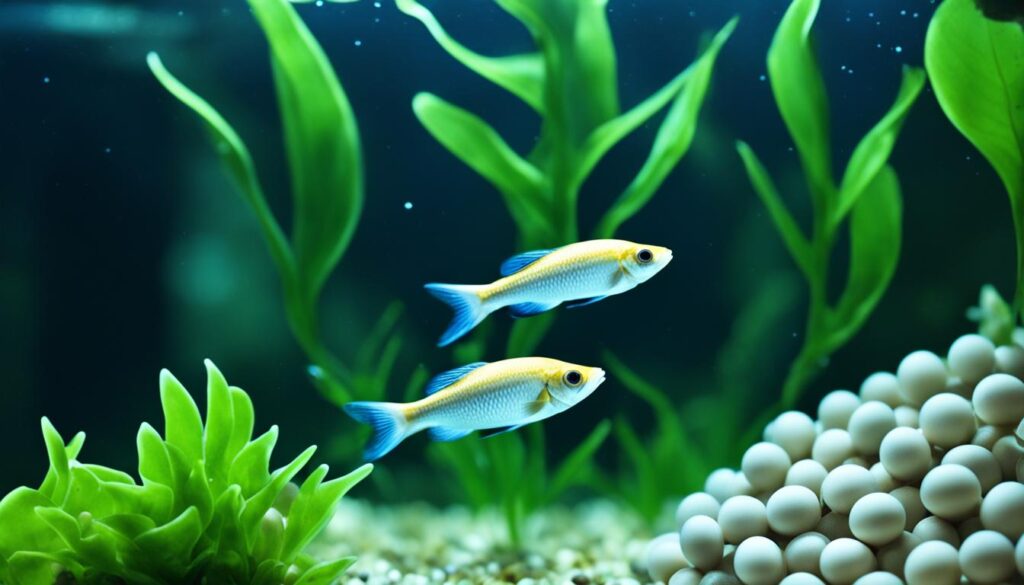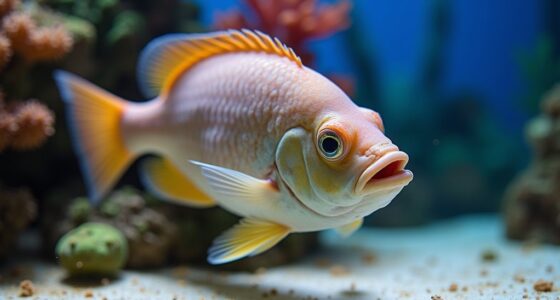Did you know that sucker fish, also known as plecos or plecs, can grow up to 12 inches long and live for 10-15 years in captivity? These intriguing freshwater fish are beloved by aquarium enthusiasts for their distinctive looks and their knack for maintaining clean tank environments. If you’re thinking about adding a sucker fish to your aquarium, it is crucial to educate yourself on how to properly care for them to guarantee that your aquatic buddy flourishes in its new habitat.
Key Takeaways:
- Sucker fish can reach up to 12 inches in length and have a lifespan of 10-15 years in captivity.
- These fish are known for their unique appearance and their ability to keep tank environments clean.
- Proper care is essential to ensure your sucker fish thrives, including providing a suitable tank environment and a well-balanced diet.
- Sucker fish are peaceful and can live with other fish, as long as the tank is not overcrowded.
- Regular tank maintenance is necessary to maintain optimal water quality for all aquarium inhabitants.
Sucker Fish Facts & Overview
Sucker fish, also known as “suctorial” fish, are fascinating freshwater species with unique characteristics and behaviors. Belonging to the family Catostomidae, these fish are primarily herbivorous or detritivorous, playing a crucial role in maintaining the health and balance of freshwater ecosystems. Let’s explore some interesting facts about these incredible bottom-feeders.
The Distinctive Mouth Structures
Sucker fish are easily recognizable by their round, suckermouths, which are specifically adapted for their feeding habits. These mouths act as powerful suction cups, allowing the fish to attach themselves to various surfaces, including rocks, plants, and even aquarium walls. This unique feature enables them to graze on algae and consume detritus, contributing to the overall cleanliness of their environment.
Impressive Bottom-Feeding Abilities
One of the key characteristics of sucker fish is their remarkable ability to consume excess algae, detritus, and small invertebrates from the bottom of freshwater habitats. By removing these unwanted elements, they help maintain water quality and prevent the overgrowth of algae, which can be detrimental to other aquatic life. Their diligent bottom-feeding behavior is essential for promoting a healthy and balanced ecosystem.
Diversity and Distribution
Sucker fish can be found in various freshwater habitats worldwide, including North America, China, and Russia. They come in a wide range of sizes, with some species growing to over two feet in length. These fish exhibit diverse physical characteristics, such as elongated bodies and unique color patterns that provide excellent camouflage in their natural surroundings. The combination of their diverse breeding and reproductive behaviors contributes to their widespread distribution and overall adaptability in different environments.
Now that we’ve discovered some fascinating facts about sucker fish, let’s delve deeper into their appearance and behavior in the next section.

Appearance & Behavior
Sucker fish are fascinating creatures with distinctive physical traits and interesting behaviors. Let’s explore their appearance and behavior in detail.
Distinctive Appearance
Sucker fish are easily recognizable by their unique round, suckermouths and elongated bodies. These fish possess fleshy, large lips that form a powerful suction force, allowing them to attach themselves to various surfaces. This adaptation enables them to graze on algae and cling onto rocks or other objects in their environment. The colors and patterns on their bodies provide excellent camouflage, helping them blend in seamlessly with their surroundings.
Curious to see how a sucker fish looks like? Take a look at the image below:

Peaceful Behavior and Feeding Habits
Sucker fish are known for their non-aggressive nature, making them suitable tank mates for other fish species. As bottom feeders, they spend a significant amount of time near the substrate of the aquarium. Here, they search for food, munching on algae and scavenging leftover food. This behavior helps to keep the tank clean and algae-free.
Due to their nocturnal tendencies, sucker fish prefer dim lighting in the tank. Providing hiding spots, such as caves or driftwood, is essential to mimic their natural habitat and ensure their comfort. Additionally, it’s important to note that sucker fish have been known to jump out of the water, so a secure lid for the tank is necessary to prevent any accidents.
In Summary
Sucker fish have a fascinating appearance, with their round, suckermouths and elongated bodies. They are non-aggressive bottom feeders, spending most of their time near the substrate, grazing on algae and scavenging for food. Their peaceful nature makes them excellent tank mates for other fish species. However, it’s important to provide adequate hiding spots and a secure lid to prevent any mishaps. Now that we understand their appearance and behavior, let’s dive deeper into their care requirements in the upcoming section.
Sucker Fish Care
Sucker fish are relatively easy to care for due to their laid-back personalities and willingness to eat leftovers. They play an important role in maintaining a clean tank environment by consuming algae and leftover food, reducing the need for frequent cleaning. To ensure the well-being of your sucker fish, there are several key care considerations to keep in mind.
Tank Size and Filtration
First, make sure you have a tank that is large enough to accommodate the size of your sucker fish. As they can grow up to 12 inches in length, adequate space is crucial for their comfort and overall health. Additionally, provide a well-functioning filter to handle their waste and maintain optimal water quality. A clean and properly filtered tank is essential for the well-being of your sucker fish.
Water Parameters
Maintaining the right water parameters is vital for the health of your sucker fish. Keep the water temperature between 72 and 78°F to ensure they thrive in their environment. The pH level should be maintained between 6.5 and 7.5. Sucker fish prefer a water hardness between 5 and 19 dH. Regularly test the water parameters and make adjustments as needed to create a suitable habitat for your fish.
Substrate and Feeding
Provide at least 2.5 inches of substrate in the tank to allow your sucker fish to burrow and feed. Sinking pellets or other suitable food should be offered to meet their dietary needs. Don’t forget to supplement their diet with fresh vegetables, such as lettuce, cucumber, zucchini, and sweet potato. These additions provide essential nutrients and variety for their overall health.
Regular Cleaning and Water Changes
Sucker fish help maintain a cleaner tank environment, but regular cleaning and water changes are still necessary. Perform routine tank cleaning to remove any excess waste and debris. Water changes ensure optimal water quality and prevent the buildup of harmful substances. Aim to change a portion of the water every one to two weeks, depending on the size of your tank and the number of fish.
By following these care tips, you can provide your sucker fish with a healthy and thriving environment. Remember to monitor their behavior and make adjustments as needed. With proper care and attention, your sucker fish will reward you with their unique presence and valuable tank-cleaning abilities.

Habitat and Tank Requirements
Creating a suitable habitat for your sucker fish is vital to ensure their well-being and happiness. Mimicking their natural freshwater rivers and lakes is key to providing a comfortable environment for these unique fish.
| Requirement | Details |
|---|---|
| Tank Setup | The tank should have a well-functioning filter that ensures clean and clear water. Sucker fish prefer slow-moving freshwater, so adjust the flow accordingly. |
| Water Parameters | Maintain a water temperature between 72 and 78°F for optimal conditions. The pH level should be kept between 6.5 and 7.5. Sucker fish thrive in water with a moderate hardness, between 5 and 19 dH. |
| Substrate | Provide at least 2.5 inches of suitable substrate, such as aquarium sand. This will allow your sucker fish to burrow and feed comfortably. |
| Plants and Decorations | Add deep-rooted and quick-growing plants to the tank. These plants serve as hiding places and contribute to the overall health of the aquarium ecosystem. Decorations like caves and driftwood also provide additional hiding spots. |
| Lid | It’s essential to have a sturdy lid for the tank to prevent the sucker fish from jumping out. This ensures their safety and eliminates the risk of accidental injuries. |
By recreating the sucker fish’s natural habitat, you can provide them with a comfortable and stimulating environment that promotes their overall well-being.

Tank Mates
When it comes to choosing tank mates for your sucker fish, it’s important to consider their peaceful nature and compatibility with other fish. Sucker fish are generally non-aggressive and can live harmoniously with a variety of tropical freshwater fish. However, a few key factors should be taken into account to ensure a peaceful coexistence in the tank.
Avoid housing your sucker fish with burrowing fish or aggressive species like eels and knife fish. These can pose a threat to the peaceful nature of your sucker fish. Instead, opt for tank mates that dwell in the top and mid-sections of the tank, as this helps prevent territorial issues and ensures everyone has their own space.
Here are some suitable tank mates for your sucker fish:
- Hatchetfish
- Pencilfish
- Certain species of cichlids

These fish are known for their peaceful nature and can coexist well with sucker fish in an aquarium. Their compatibility leads to a more harmonious tank environment, where everyone can thrive. It’s important to note that compatibility can vary depending on the individual personalities of the fish, so observation is crucial when introducing new tank mates.
On the other hand, it’s best to avoid housing your sucker fish with crabs and snails. Sucker fish may nip at or potentially consume these creatures, leading to an imbalance in your tank ecosystem. By selecting compatible tank mates, you can ensure a peaceful and thriving community within your aquarium.
Diet and Feeding
When it comes to the diet and feeding habits of sucker fish, it’s important to understand their role as algae eaters and their preference for scavenging at the bottom of the tank. Sucker fish are primarily herbivorous, and their diet consists of algae and leftover food in the tank.
To ensure their nutritional needs are met, it’s recommended to provide sinking pellets or algae wafers specifically formulated for sucker fish. These sinking foods mimic their natural feeding behavior, as they scrounge for food at the bottom of the tank.

In addition to prepared foods, it’s beneficial to supplement their diet with fresh vegetables. Sucker fish particularly enjoy lettuce, cucumber, zucchini, and sweet potato. To prevent these fresh foods from floating, you can attach them to a rock using a rubber band.
For optimal feeding, it’s best to feed your sucker fish in the evening and remove any leftovers in the morning to prevent water murkiness and maintain good water quality. It’s important to note that in a well-populated tank, enough food should fall to the bottom to ensure all the sucker fish have access to food.
Key Points:
- Sucker fish are primarily herbivorous, feeding on algae and leftover food.
- Sinking pellets or algae wafers are ideal for their diet, as they scrounge for food at the bottom of the tank.
- Supplement their diet with fresh vegetables like lettuce, cucumber, zucchini, and sweet potato, attached to a rock to prevent floating.
- Feed them in the evening and remove any leftovers in the morning to maintain good water quality.
Breeding
Sucker fish are fascinating creatures that display a range of breeding and reproductive behaviors. Depending on the species, some sucker fish are egg-layers, while others are live-bearers. Egg-laying species typically bury their eggs in the substrate or attach them to plants and rocks, providing a suitable environment for incubation. On the other hand, livebearers give birth to fully developed fry, bypassing the egg stage altogether.

Breeding sucker fish in a home aquarium can be a rewarding but challenging endeavor. These fish have specific requirements and triggers that must be met to initiate the breeding process successfully. Before attempting breeding, it is crucial to research the specific breeding requirements for the species you have.
“Breeding sucker fish requires careful consideration of species-specific requirements and triggers.”
Some factors that influence sucker fish breeding include water parameters, tank setup, and the reproductive behavior of the particular species. These fish thrive in water conditions that replicate their natural habitat, so maintaining optimal water quality is crucial. Additionally, providing suitable hiding places, such as caves or vegetation, can encourage spawning behavior and provide a safe environment for the eggs or fry.
If you are interested in breeding sucker fish, it is recommended to start with a well-established and healthy group of fish. Ensure that both males and females are present and that the tank conditions meet their specific needs. Provide a balanced diet and monitor their behavior closely for any signs of courtship or territorial displays.
Comparison of Egg-Laying and Live-Bearing Sucker Fish
| Egg-Laying Sucker Fish | Live-Bearing Sucker Fish |
|---|---|
| Deposits eggs in the substrate or attaches them to plants and rocks | Give birth to fully developed fry |
| Requires specific conditions for successful egg incubation | No need for incubation period |
| Increased vulnerability during egg incubation | Fry are more independent and have a higher survival rate |
Table: Comparison of Egg-Laying and Live-Bearing Sucker Fish
Both egg-laying and live-bearing sucker fish display fascinating reproductive strategies. While egg-laying species require careful management and monitoring during the incubation period, live-bearing species provide a higher chance of survival for their offspring. Breeding sucker fish in captivity allows us to observe the wonders of their reproductive behaviors and contribute to their preservation in the aquarium hobby.
Should You Get a Sucker Fish for Your Aquarium?
Adding a sucker fish to your aquarium can be a fantastic choice for both pet fish enthusiasts and those looking to keep their tank clean and well-maintained. Sucker fish, also known as plecos or plecs, have unique attributes that make them a popular choice among aquarium enthusiasts. Their interesting appearance, laid-back personalities, and tank-cleaning abilities make them a beneficial addition to most aquariums.
However, before deciding to get a sucker fish as a pet, there are a few factors you should consider. It’s important to provide the right care and create an environment that suits their specific needs to ensure their well-being and overall satisfaction.
Caring for Sucker Fish
Sucker fish require a large tank as they grow bigger. These fish can reach up to 12 inches in length, depending on the species. It’s crucial to provide them with a spacious environment, allowing them to swim freely and thrive.
In addition to tank size, water parameters are essential for the health of your sucker fish. Maintaining optimal water quality is crucial, as poor water conditions can lead to stress, disease, and even death. Regular aquarium maintenance, such as cleaning the tank and conducting water changes, is necessary to ensure a healthy living environment for both the sucker fish and other inhabitants of the tank.
Proper diet is another crucial aspect of sucker fish care. While they help keep the tank clean by consuming algae and leftover food, it’s essential to supplement their diet with appropriate food. Sinking pellets or algae wafers formulated for sucker fish should be provided regularly. Fresh vegetables, such as lettuce, cucumber, zucchini, and sweet potato, can also be added to their diet as a healthy treat.
Here’s a summary of key points to consider before getting a sucker fish for your aquarium:
| Considerations | Details |
|---|---|
| Tank Size | Provide a large tank to accommodate their growth. |
| Water Parameters | Maintain optimal water quality through regular tank maintenance. |
| Diet | Supplement their diet with sinking pellets, algae wafers, and fresh vegetables. |
By taking these considerations into account and providing the appropriate care, a sucker fish can be a delightful and beneficial addition to your aquarium. They not only add a unique element to your tank but also contribute to its cleanliness and overall ecosystem balance.
Conclusion
In summary, sucker fish are fascinating freshwater fish that can make a great addition to your aquarium. With their distinctive mouth structures and ability to keep the tank clean, they offer both aesthetic appeal and functional benefits. By providing them with a suitable tank environment that mimics their natural habitat, offering a well-balanced diet, and caring for their specific needs, you can ensure that your sucker fish thrives and lives a happy, healthy life.
Sucker fish are generally peaceful and can coexist with other fish in the same tank, as long as the tank is not overcrowded. However, it’s important to pay attention to tank size and compatibility when choosing tank mates. Remember to maintain optimal water quality through regular cleaning and water changes, as this is crucial for the overall health and well-being of all the aquarium inhabitants.
In conclusion, keeping a sucker fish in your aquarium can be a rewarding experience. Not only do they provide visual interest with their unique appearance, but they also contribute to the cleanliness and balance of the tank ecosystem. Enjoy the presence of these amazing creatures, and let them bring a touch of nature and tranquility into your home aquarium.










